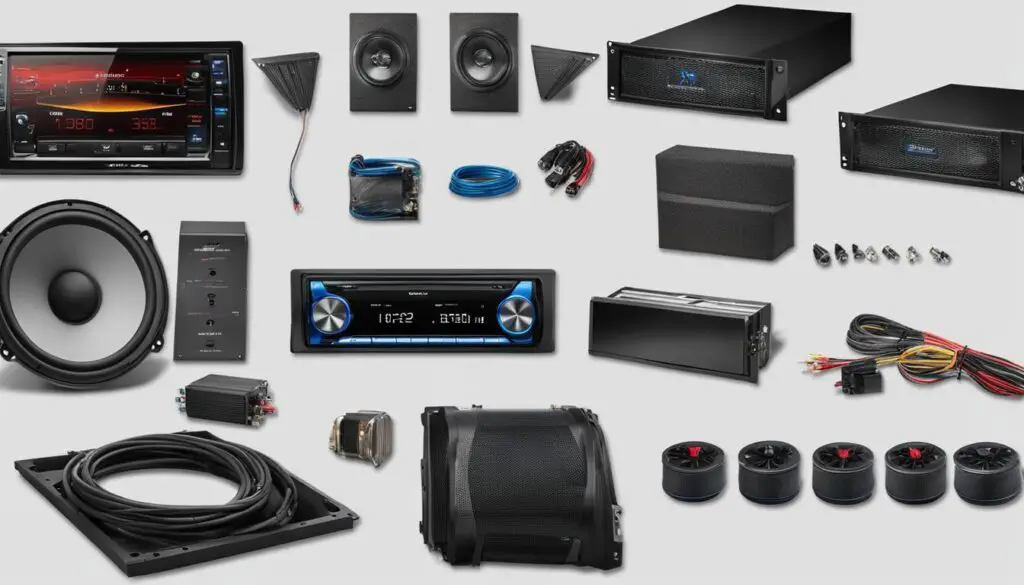
Comprehensive Guide to Car Audio System Upgrades
As a professional copywriting journalist, I understand the importance of having a high-quality car audio system. Upgrading your car audio system can make all the difference in your driving experience, whether you’re a music lover or just want better sound quality while on the road. In this guide, I will provide you with the essential tips and advice you need to know to upgrade your car audio system.
From choosing the right components to installation, this guide will cover everything you need to know to ensure your car’s sound system is top-notch. Whether you’re a beginner or a seasoned enthusiast, these tips and advice will help you take your driving experience to the next level.
Key Takeaways:
- Upgrading your car audio system can greatly enhance your driving experience.
- Choosing the right components is essential to ensuring optimal sound quality.
- Installation plays a crucial role in the effectiveness of your car audio system upgrade.
- There are several reliable car audio system brands to consider.
- Budget is an important factor to consider when calculating the overall cost of your car audio system upgrade.
DIY Car Audio System Upgrade: Tips and Tricks
If you’re looking to upgrade your car audio system on your own, there are a few essential components to consider.
First, you’ll need a new head unit or radio. This is the control center of your audio system and determines sound quality and features. Some things to consider when choosing a head unit include compatibility with your car’s make and model, the ability to play various audio formats, and Bluetooth connectivity for hands-free phone calls and audio streaming.
Second, you’ll need speakers. There are a variety of car audio system brands to choose from, so do your research to find the ones that fit your needs and budget. When upgrading your speakers, make sure they are compatible with your head unit and that they are the right size to fit in your vehicle.
Third, you may want to consider adding an amplifier. An amplifier can help boost the power and clarity of your sound system, especially if you’re adding subwoofers or larger speakers.
Once you have your components, it’s time to install them. Follow a car audio system installation guide carefully to avoid damaging your car or components. It’s also important to troubleshoot any issues that may arise during or after installation.
Below is a table with some popular car audio system brands to consider when upgrading your system:
| Brand | Type of Component |
|---|---|
| Pioneer | Head Unit, Speakers |
| Kicker | Speakers, Amplifiers |
| Alpine | Head Unit, Amplifiers |
| JL Audio | Speakers, Amplifiers |
As you upgrade your car audio system, troubleshooting may be necessary. If you experience any issues like distortion or static, check your wiring and connections first. It’s also helpful to have a car audio system troubleshooting guide on hand in case of any other problems.
With these tips and tricks, you’ll be well on your way to upgrading your car audio system and enjoying optimal sound while on the road.

Conclusion: Consider Your Budget When Calculating the Cost of Upgrading Your Car Audio System
Upgrading your car audio system can significantly improve your driving experience. However, before making a purchase, it’s important to factor in the cost of the upgrade. Many different components go into a car audio system upgrade, and the prices can vary depending on the brand and quality of the components.
When determining the cost of your car audio system upgrade, consider your budget and what features are most important to you. A high-end sound system may not be necessary if you’re on a tight budget, but there are still affordable options that can enhance the sound quality of your current system.
Some factors that can affect the cost of your car audio system upgrade include the type of speakers, amplifiers, and subwoofers you choose, as well as installation fees if you opt for professional installation. Doing the installation yourself can save you money, but it’s important to have the right tools and knowledge to ensure a successful upgrade.
In summary, upgrading your car audio system is an investment that can greatly enhance your driving experience. However, it’s important to consider the cost and your budget before making a purchase. By doing your research and choosing the right components, you can achieve optimal sound quality on the road without breaking the bank.
FAQ
What components do I need to upgrade my car audio system?
To upgrade your car audio system, you will need to consider the following components: a head unit, speakers, amplifiers, subwoofers, and wiring. These components work together to improve the overall sound quality and performance of your car audio system.
How do I install a car audio system?
Installing a car audio system can be a complex process, but with the right tools and instructions, it is possible to do it yourself. Here is a basic step-by-step installation guide:
1. Disconnect the negative battery terminal.
2. Remove the old head unit and disconnect all the wiring.
3. Install the new head unit and connect the wiring.
4. Install the speakers and secure them in place.
5. Connect the speaker wiring to the head unit or amplifier.
6. Install the amplifier and connect the wiring.
7. Install the subwoofer(s) and connect the wiring.
8. Double-check all connections and test the system before reassembling the car interior.
What are some reliable car audio system brands?
There are several reputable car audio system brands to choose from, including Pioneer, Alpine, JBL, Kenwood, Rockford Fosgate, and Sony. These brands are known for their quality products and have a wide range of options to suit different budgets and preferences.
How can I troubleshoot issues with my car audio system?
If you encounter any issues with your car audio system, here are some troubleshooting tips:
– Check all the connections to ensure they are secure and properly connected.
– Make sure the head unit is receiving power and turned on.
– Check the speaker wiring for any damage or loose connections.
– Test the speakers individually to identify any faulty ones.
– Adjust the settings on the head unit to ensure the sound is balanced and optimized for your preferences.
If you are still experiencing problems, it is recommended to consult a professional car audio technician for further assistance.
